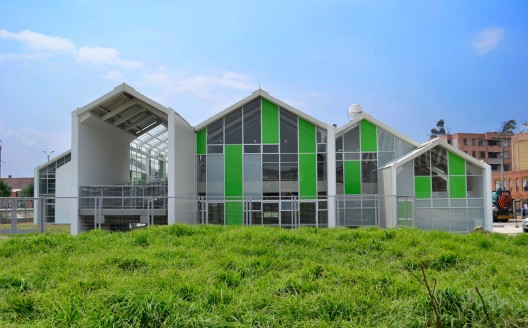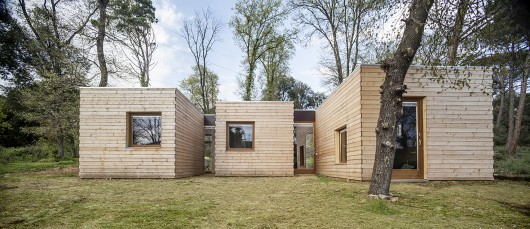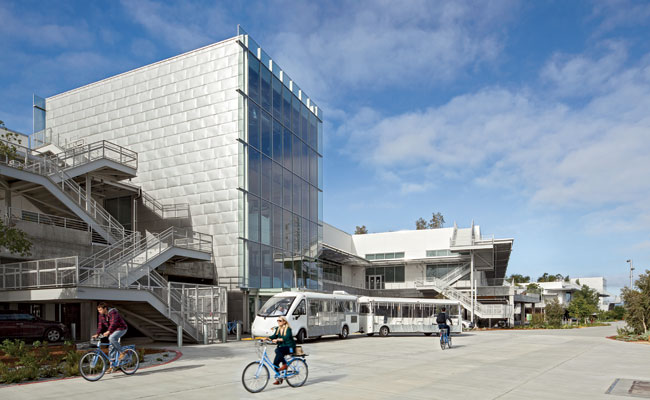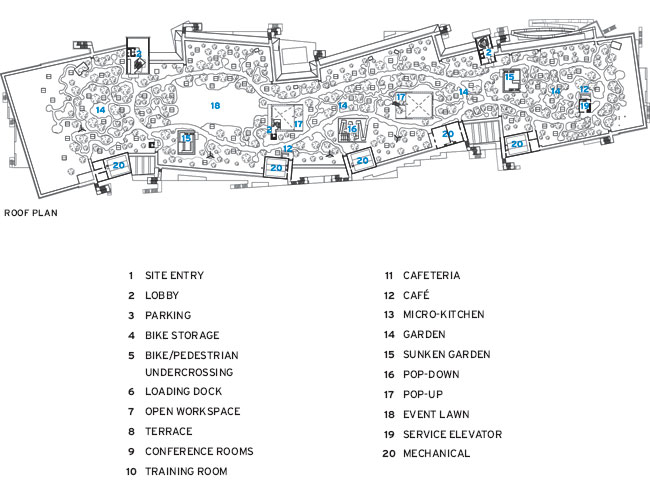 |
| Source: Kouji Okamoto archdaily.com |
 |
| Diagram, Source: archdaily.com |
9 Gathered Huts, Kitakyushu, Fukuoka, Japan, 2008 designed by NKS Architects
This is a clinic situated on the boundary between urban and rural area. A
flat single story building with a square roof is harmonized with the
surrounding landscape. The 9 small huts with size variation
corresponding to the necessary functions of the clinic are settled under
the flat roof. To make the whole structure stable and to control the interior light
condition, the 9 huts are turned each other in 90 degrees. Consequently
these huts create the settlement like atmosphere. The circulation space
and a waiting space became streets and a plaza. --
ArchDaily
 |
| Source: Iwan Baan archdaily.com |
 |
| Plan/Section, Source: archdaily.com |
House O, Tokoro District, Hokkaido Prefecture, Japan, 2009 designed by Jun Igarashi Architects
The smallest plan of each program is cut out to be placed in a location
and orientation that is favorable. For example, the kitchen is placed in
a “selfish” way to look out to the tree garden on the site, and then
connected the dinning to the kitchen. With this method, the extra
circulation corridors to connect the spaces and hierarchy due to its
location and orientation are omitted. --
ArchDaily
 |
| Source: Demos Arquitectos archdaily.com |
 |
| Plan, Source: archdaily.com |
El Caracol Kindergarten, Patio Bonito, Bogotá, Colombia, 2011 designed by Demos Arquitectos
This kindergarten proposal recreates as main idea the urban life within the project. The building is understood as the very early contact between the child and the society where the formation and development process are going to begin. From this perspective the proposal reproduces a small neighborhood taking the primary elements that make up the city, the house, the street, the play park, as composition themes of the architectural scheme. -- ArchDaily
 |
| Source: Francisco Nogueira archdaily.com |
 |
| Plan, Source: archdaily.com |
House in Belas, 2715-311 Belas, Portugal, 2012 designed by CHP Arquitectos
The design intends to express a contemporary look onto the main aspects of traditional Portuguese architecture, with special attention to the balance and harmony between each building. The house consists of five different bodies, linked through passages. Spaces between each body create a series of relationships, distances and views are generated, providing a rich and diverse atmosphere. The social areas are located in the core of it all, benefitting from the surrounding environment, and allowing a simple and functional distribution throughout the house. -- ArchDaily
 |
| Source: Miguel de Guzmán archdaily.com |
 |
| Plan, Source: archdaily.com |
MO House, Madrid, Spain, 2012 designed by FRPO
The MO House project belongs to a family of projects developed in the office beginning in 2005. These projects explore the possibilities of generating architectural complexity out of the combination of simple elements. Throughout this process of projects, conditioned by a large number of program specifications settled by the clients, we have been forced to systematize every design decision in order to simplify the process to its full capacity. The results produced a nice surprise: the combination of a number of extremely simple spaces offered an extremely rich spatial experience. -- ArchDaily
 |
| Source: Torben Petersen archdaily.com |
 |
| Plan, Source: archdaily.com |
Summerhouse, Zealand, Denmark, 2012 designed by JVA
 |
| Source: Eiji Tomita archdaily.com |
 |
| Diagram, Source: archdaily.com |
House of Awa-cho, Awa, Tokushima Prefecture, Japan, 2013 designed by Container Design
....combining square units in a radial direction, with an interior courtyard. The units are connected interiorly, thus providing some privacy. -- ArchDaily
 |
| Source: Adrià Goula archdaily.com |
 |
| Plan, Source: archdaily.com |
GG Bioclimatic House, Santa Maria de Palautordera, Barcelona, Spain, 2013 designed by Alventosa Morell Arquitectes
....6 modules that adapt autonomously to the site respecting and framing the existing trees. The interstitial space that joins them transforms based on comfort and
the use of its inhabitants, becoming a solar collector during the winter
with a greenhouse effect, and a covered outdoor terrace linked to the
garden during summer. --
ArchDaily
 |
| Source: Radek Wojnar archdaily.com |
 |
| Plan, Source: archdaily.com |
Podkowa House, Warsaw, Poland, 2013 designed by Jakub Szczęsny + Ryszard Szczęsny
....the house had to respond to it’s primary condition of need to maintain
maximum of existing trees, which could be obtained only through fitting
structure’s shape into the trees. --
ArchDaily
 |
| Source: Henning Köpke München archdaily.com |
 |
| Plan, Source: archdaily.com |
Familienzentrum im Steinpark Kindergarten, Freising, Germany, 2013 designed by nbundm
....the idea behind the design of putting the various rooms in separate
buildings, creating a kind of “children’s village”, led to the
star-shaped design of the facility, and to the placement of the
different age-groups into individual and structurally separated
buildings. Each unit – crèche, kindergarten, day-care centre, utility
and staff – is given its own building. They are connected with each
other by means of a central all-purpose hall, which we called the
“Piazza”, and which is the heart of the child-care facility. --
ArchDaily
 |
| Source: Hiroyuki Oki archdaily.com |
 |
| Plan, Source: archdaily.com |
Son La Restaurant, Son La, Son La, Vietnam, 2014 designed by Vo Trong Nghia Architects
....the building is composed by 8 separate stone buildings and a open air
bamboo dining hall to supply both contained air-conditioned rooms and
comfortable exterior dining. The stone buildings provide multiple
entrances to the dining hall and multiple framed views out from the
external dining area. --
ArchDaily
 |
| Source: Adam Mørk archdaily.com |
 |
| Plan, Source: archdaily.com |
City in the City, 211 18 Malmö, Sweden, 2015 designed by Schmidt Hammer Lassen Architects
The different functions of the building are organised as separate
elements to resemble a small city. The lobby becomes the street, which
runs through the entire ground floor and ties everything together. Like
medieval cities, which had curved, narrow streets organised around
plazas and squares, the lobby is designed to form small gathering places
and recesses where visitors can stop, sit and enjoy the view of the
canal and the park. --
ArchDaily
 |
| Source: archrecord.construction.com |
 |
| Plan, Source: archrecord.construction.com |
Facebook Building 20
, Menlo Park, California, USA, 2015 designed by Gehry Partners
“We created a little city under the roof—we practiced indoor urbanism.”
This “city” is designed without a regular office grid, giving it an ad-hoc, organic quality. A meandering path runs down each side of the building, with several cross-streets.
-- Architectural Record
 |
| Source: Niels Nygaard archdaily.com |
 |
| Plan, Source: archdaily.com |
VIA University College
, Aarhus, Denmark, 2015 designed by Arkitema Architects
The structure of VIA Campus is created based on the existing buildings
in the town; like “a city within the city”, that actively integrates the
urban space and the nature of the valley in Aarhus.
Four organizing key elements establish the backbone of VIA Campus C -
Knowledge Square, Learning Street, Culture House and the Learning
Clusters. --
ArchDaily




























No comments:
Post a Comment